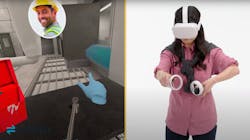VR Simulations Used for Electrical Skills Training
Skills training platform Transfr launched a new package of simulations that harness the power of virtual reality (VR) and augmented reality to help organizations of all kinds create pathways to careers in electrical construction. The VR simulations are designed to equip learners with the foundational knowledge and skills to prepare them for apprenticeships and jobs in the fast-growing electrical construction industry.
The latest collection of simulations was built in collaboration with TRIO Electric, a Houston-based electrical design, construction, and service firm that has been using the simulations as part of its own workforce training programs.
“The COVID-19 pandemic spurred us to think creatively about how we can train the next generation of electrical construction workers in a scalable and cost-effective way,” said Beau Pollock, president and CEO of TRIO Electric. “Finding electrical instructors is difficult and time-consuming, and training requires us to use the same materials that technicians use on the job. The virtual simulations not only offer learners real-world experience and hands-on practice before they go into the field, they also help us to conserve resources in the process.”
According to the National Electrical Contractors Association, electrical construction represents a $202 billion industry that provides Americans with power, light, and communication technologies, employing more than 650,000 workers. Demand for electricians is expected to grow by 9% through 2030, with an average of 84,700 openings for electricians each year, on average, over the decade. The median annual wage for an electrician is more than $60,000 — a well-paying career path that does not require a four-year degree.
The simulations are being used by high school and community college students as well as adults looking for careers and apprenticeships in electrical construction. Students cover key topics such as workplace safety, material and tool recognition and usage, wall rough-in, overhead box installation, wire pulling, conduit bending, and other foundational skills required to become a trained, productive and safe electrical worker.
Delivered in concert with employers, colleges, and workforce development organizations, these simulations enable learners to feel as though they are embedded in the physical environment and experience of an actual worksite. Transfr's approach guides trainees through hands-on skills sessions with the assistance of a digital coach that adapts to their performance, all in a fully-immersive, 360-degree environment that is distraction-free and safe from many of the risks of traditional electrical construction learning.
“To keep pace with the complex demands of the electrical industry, employers are in search of new and creative ways to develop the skilled workforce that this dynamic industry demands — and meet our country’s light, power, and connectivity needs,” said Bharani Rajakumar, CEO of Transfr. “This is about harnessing the potential of virtual and augmented reality to help more aspiring tradespeople not only learn about careers in electrical work, but gain the invaluable on-the-job experience they need to launch their careers.”
To learn more about using VR to train for careers in electrical construction, visit www.transfrinc.com/ec.
